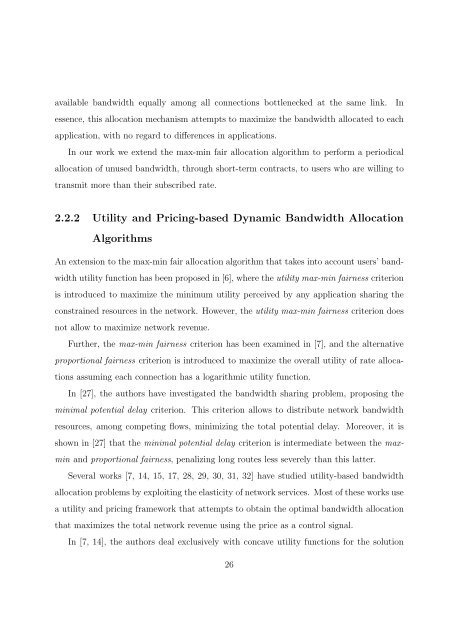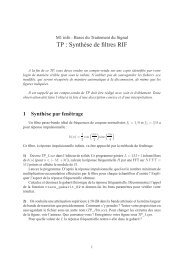Th`ese de Doctorat de l'université Paris VI Pierre et Marie Curie Mlle ...
Th`ese de Doctorat de l'université Paris VI Pierre et Marie Curie Mlle ...
Th`ese de Doctorat de l'université Paris VI Pierre et Marie Curie Mlle ...
Create successful ePaper yourself
Turn your PDF publications into a flip-book with our unique Google optimized e-Paper software.
available bandwidth equally among all connections bottlenecked at the same link. In<br />
essence, this allocation mechanism attempts to maximize the bandwidth allocated to each<br />
application, with no regard to differences in applications.<br />
In our work we extend the max-min fair allocation algorithm to perform a periodical<br />
allocation of unused bandwidth, through short-term contracts, to users who are willing to<br />
transmit more than their subscribed rate.<br />
2.2.2 Utility and Pricing-based Dynamic Bandwidth Allocation<br />
Algorithms<br />
An extension to the max-min fair allocation algorithm that takes into account users’ band-<br />
width utility function has been proposed in [6], where the utility max-min fairness criterion<br />
is introduced to maximize the minimum utility perceived by any application sharing the<br />
constrained resources in the n<strong>et</strong>work. However, the utility max-min fairness criterion does<br />
not allow to maximize n<strong>et</strong>work revenue.<br />
Further, the max-min fairness criterion has been examined in [7], and the alternative<br />
proportional fairness criterion is introduced to maximize the overall utility of rate alloca-<br />
tions assuming each connection has a logarithmic utility function.<br />
In [27], the authors have investigated the bandwidth sharing problem, proposing the<br />
minimal potential <strong>de</strong>lay criterion. This criterion allows to distribute n<strong>et</strong>work bandwidth<br />
resources, among comp<strong>et</strong>ing flows, minimizing the total potential <strong>de</strong>lay. Moreover, it is<br />
shownin[27]thattheminimal potential <strong>de</strong>lay criterion is intermediate b<strong>et</strong>ween the max-<br />
min and proportional fairness, penalizing long routes less severely than this latter.<br />
Several works [7, 14, 15, 17, 28, 29, 30, 31, 32] have studied utility-based bandwidth<br />
allocation problems by exploiting the elasticity of n<strong>et</strong>work services. Most of these works use<br />
a utility and pricing framework that attempts to obtain the optimal bandwidth allocation<br />
that maximizes the total n<strong>et</strong>work revenue using the price as a control signal.<br />
In [7, 14], the authors <strong>de</strong>al exclusively with concave utility functions for the solution<br />
26










